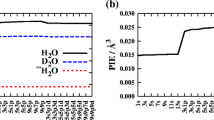Abstract
A previously developed scheme for describing the effects of substituents on the physicochemical characteristics of molecules with conjugated bonds has been extended to systems with an open electron shell. The distribution of spin density has been found for a number of anion radicals of azines on the basis of a calculation of their hydrocarbon analogs. The results are in agreement with experimental values of the HFI constant in the ESR spectra of these compounds.
Similar content being viewed by others
Literature cited
Yu. B. Vysotskii, “Effect of chemical substitution ionization potentials and electron affinity of systems with conjugated bonds,” Teor. Éksp. Khim.,17, No. 4, 469–478 (1981).
R. E. Moss, N. A. Ashford, R. G. Lawler, and G. K. Fraenkel, “Electron spin resonance spectra of methyl-substituted naphthalene anion-radicals,” J. Chem. Phys.,51, No. 5, 1765–1771 (1969).
K. K. Sharma, “Additivity model for calculations of UHF spin densities and charge densities in some methyl-substituted anion radicals,” Int. J. Quantum Chem.,11, No. 5, 753–758 (1977).
K. K. Sharma, “Additivity model for calculations of UHF spin densities in some aza-aromatic anion radicals,” Int. J. Quantum Chem.,13, No. 5, 635–639 (1978).
A. V. Luzanov, M. M. Mestechkin, and Yu. B. Vysotskii, “Calculation of spin perturbations in the Hartree-Fock method,” Zh. Strukt. Khim.,12, No. 2, 289–295 (1971).
V. É. Umanskii and A. V. Luzanov, “Program for calculation of perturbation effects and π-electron spectra for open shells in the unrestricted Hartree-Fock method,” Vopr. Vychisl. Mat. Tekh. (Naukova Dumka, Kiev), pp. 74–85 (1976).
M. M. Mestechkin, The Density Matrix Method in Molecular Theory [in Russian], Naukova Dumka, Kiev (1977).
M. M. Mestechkin, Instability of Hartree-Fock Equations and the Stability of Molecules [in Russian], Naukova Dumka, Kiev (1986).
M. M. Mestechkin, V. N. Poltavets, V. É. Umanskii, et al., “Approximate calculation of alternative systems in spin-extended Hartree-Fock method,” Teor. Éksp. Khim.,13, No. 3, 321–327 (1977).
E. Yu. Balabanov, O. I. Kachurin, L. S. Gutyrya, and Yu. B. Vysotskii, “Electronic structure and atomatom mutual polarizabilities of anion radicals of benzenoid hydrocarbons,” Donetsk (1985), paper filed at VINITI.
Yu. B. Vysotskii and B. P. Zemskii, “Quantumchemical interpretation of recyclization reactions. 3. Azaindolizines,” Khim. Geterotsikl. Soedin., No. 7, 984–992 (1980).
G. P. Colpa and G. R. Bolton, “Hyperfine coupling constants and their dependence on charge densities,” Mol. Phys.,6, No. 3, 273–282 (1963).
A. L. Buchachenko and A. M. Vasserman, Stable Radicals [in Russian], Khimiya, Moscow (1973).
A. V. Il'yasov, Yu. M. Kargin, and I. D. Morozova, ESR Spectra of Organic Radicals [in Russian], Nauka, Moscow (1980).
P. Hanson, “Heteroatomic radicals. 1. General properties; radicals with Group V ring heteroatoms,” Adv. Heterocycl. Chem.,25, 205–301 (1979).
G. D. Zeiss and M. A. Whitehead, “Heteroatomic molecules: Calculations of proton and14N hyperfine splittings,” Trans. Faraday Soc., No. 3, 526–538 (1972).
A. J. L. Sevenster and B. J. Tabner, “Electron spin resonance study of some polycyclic nitrogen heterocyclic radical anions,” Org. Magn. Reson.,22, No. 8, 521–526 (1984).
E. W. Stone, “ESR study of polyazine anions,” J. Chem. Phys.,39, No. 5, 1635–1644 (1963).
D. M. W. Ham van den, I. I. Sart, and D. Meer, “The McConnell equation for ESR spectra of symmetrical diazanaphthalenes,” Mol. Phys.,21, No. 6, 989–997 (1971).
P. Cavalieri d'Oro, R. Danieli, G. Maccagnani, et al., “Spin densities in some diazine and naphthyridine anions,” Mol. Phys.,20, No. 2, 365–374 (1971).
R. Danieli, L. Lunazzi, and G. Placucci, “Tetraazanaphthalene radical anions,” J. Am. Chem. Soc.,93, No. 22, 5850–5852 (1971).
I. C. Lewis and L. S. Singer, “Electron spin resonance of radical cations produced by the oxidation of aromatic hydrocarbons with SbCl5,” J. Chem. Phys.,43, No. 8, 2712–2727 (1965).
F. Gerson, “ESR spectra of 1,3,6,8-tetraazapyrene radical ion,” Helv. Chim. Acta,47, No. 6, 1484–1496 (1964).
D. H. Geske and G. R. Padmanabhan, “An electron spin resonance study of the anion radicals of 9,10-diazaphenanthrene and 2,2'-bipyrimidine,” J. Am. Chem. Soc.,87, No. 8, 1651–1663 (1965).
J. C. M. Henning, “14N hyperfine structure in ESR spectra of heterocyclic anions,” J. Chem. Phys.,44, No. 5, 2139–2155 (1966).
A. Sta>sko, “Intermediate radical products formed in catalytic systems of nickel with organometallic compounds,” Chem. Zvesti,37, No. 1, 95–137 (1983).
J. Chaudhuri, S. Kume, J. Jagur-Grodzinski, and M. Szwars, “Chemistry of radical anions of heterocyclic aromatics. Electron spin resonance and electron spectra,” J. Am. Chem. Soc.,90, No. 23, 6421–6425 (1968).
J. Bruhin and F. Gerson, “The radical anion of 2,7-diazapyrene, a change in orbital sequence on protonation,” Helv. Chim. Acta,58, No. 8, 2422–2431 (1975).
G. Gooijer, N. H. Velthorst, and C. MacLean, “The electron spin density at the alkali nucleus in radical ion pairs of nitrogen containing aromatic molecules and sodium,” Mol. Phys.,24, No. 6, 1361–1371 (1972).
M. M. Mestechkin, Yu. B. Vysotskii, L. S. Gutyrya, and G. E. Vaiman, “Self-consistent π-electron spin densities in alternant radicals,” Teor. Éksp. Khim.,11, No. 3, 362–368 (1975).
Author information
Authors and Affiliations
Additional information
Translated from Teoreticheskaya i Éksperimental'naya Khimiya, Vol. 25, No. 2, pp. 155–161, March–April, 1989.
Rights and permissions
About this article
Cite this article
Vysotskii, Y.B., Balabanov, E.Y., Kachurin, O.I. et al. Accounting for effects of AZA-substitution on hyperfine interaction constants in ESR spectra. Theor Exp Chem 25, 140–146 (1989). https://doi.org/10.1007/BF01135002
Received:
Issue Date:
DOI: https://doi.org/10.1007/BF01135002



